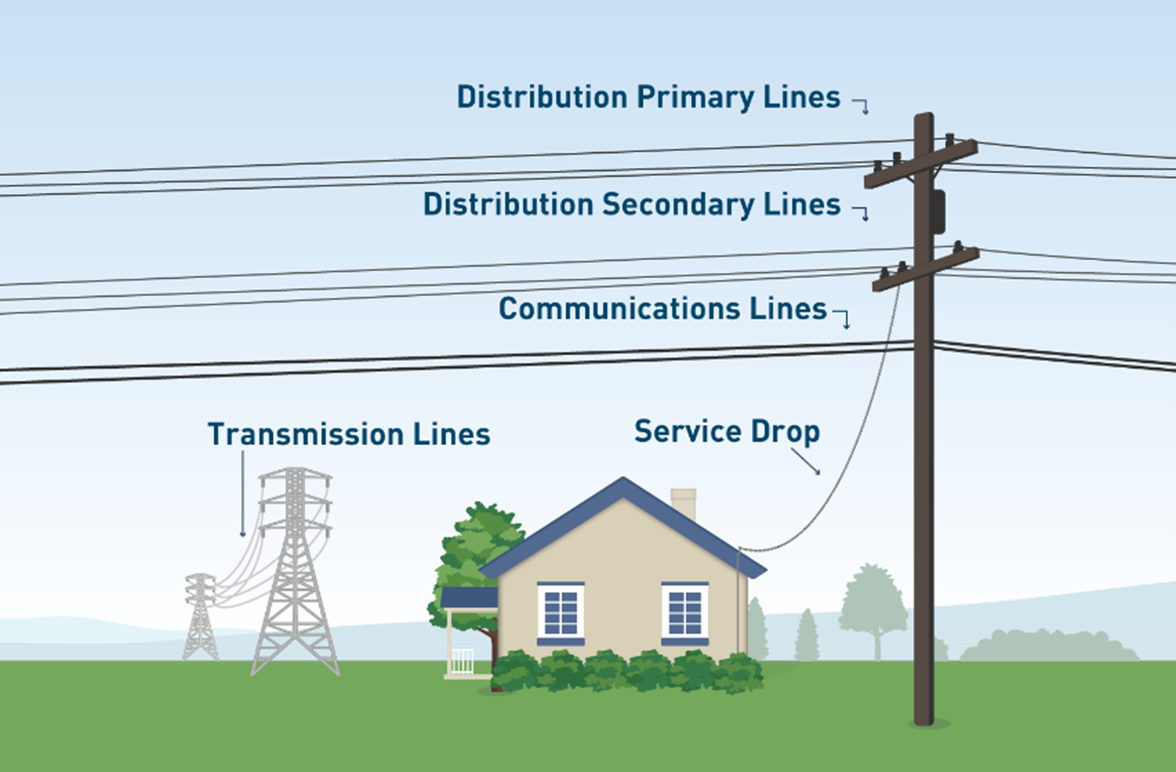Error: Field cannot be left blank.
Error: Invalid entry. Do not use equal signs [=] or colons [:].
This summary is not available. For more details, open this PDF.
- Still need assistance? Try the Help Center.
- Link accounts. Learn how to link your accounts or access more accounts.
- CARE. Find out if you qualify for a discount.
- Medical Baseline. Learn how to apply.
- Rebates. Explore PG&E rebates for your home.
- Outages. Report and view electric outages.
- Jobs/Careers. Find out about jobs at PG&E.
Error: Field cannot be left blank.
Error: Invalid entry. Do not use equal signs [=] or colons [:].
This summary is not available. For more details, open this PDF.
- Still need assistance? Try the Help Center.
- Link accounts. Learn how to link your accounts or access more accounts.
- CARE. Find out if you qualify for a discount.
- Medical Baseline. Learn how to apply.
- Rebates. Explore PG&E rebates for your home.
- Outages. Report and view electric outages.
- Jobs/Careers. Find out about jobs at PG&E.
Keeping trees away from powerlines
We inspect approximately 100,000 miles of overhead powerlines annually. Based on our inspections, we prune or cut down more than one million trees each year that are too close to a powerline and may cause a wildfire or power outage. We also perform additional inspections and tree work in areas at a high fire risk. Through these efforts, we are not only meeting, but exceeding state standards to keep our communities safe.
We inspect all trees and shrubs near powerlines to ensure we are only addressing those that pose a safety concern. High fire-threat locations are inspected more than once a year to ensure trees are a safe distance from the lines.
Every year, we are:
- Pruning trees to meet or exceed state vegetation and fire safety standards.
- Cutting down dead or dying trees.
- Pruning or cutting down trees so crews can install stronger, more resilient equipment.
- Performing extra safety work in high fire-threat areas to address vegetation near electric poles and powerlines.
We are continually updating and improving our vegetation practices to reduce wildfires. In addition to our annual tree work, in high fire-threat areas, we are:
- Utilizing our latest wildfire risk model to identify trees that may cause a power outage or start a fire.
- Pruning and cutting down trees in areas that historically experienced a high volume of tree-related outages.
- Using trained and certified arborists to determine which trees near powerlines need to be cut down for safety.
This work is performed by our highly-trained team that includes professionals who hold credentials from the International Society of Arboriculture (ISA). ISA is a non-profit organization that promotes the professional practice of arboriculture throughout the world. Through their industry-recognized credential process, our workforce includes Certified Arborists, Certified Tree Climbers, Tree Risk Assessment Qualified (TRAQ) Inspectors and more.
You can reduce future pruning and promote safety by planting the right tree in the right place.
Download the Pole Clearing Fact Sheet (PDF)
- Highest-voltage powerlines (60 kV-500 kV) that transport electricity across the state to entire cities and towns.
- Typically located on large metal towers up to 180 feet tall and sometimes on wooden poles.
- Maintained by PG&E.
- High-voltage powerlines that deliver electricity to neighborhoods and communities over a shorter distance than transmission lines.
- Generally located on the top half of wood poles, above communication lines and service drops.
- Maintained by PG&E.
- Cables that transmit television, internet, phone or other services to the community from the service provider.
- Maintained by the service provider.
- Electric wires that transport electricity from the pole to the service delivery point of a home or business.
- Maintained by the customer. Customers can disconnect their services before working around the service wires. To learn about stopping PG&E services and requesting a free temporary service disconnect, visit Start/Stop Service.
Tree work near distribution & transmission lines
Tree work near distribution lines
We work to maintain the following minimum clearances around distribution lines:
- 18 inches in non-high fire-threat areas.
- 4 feet in High Fire-Threat Districts (HFTD)* with 12 feet recommended at the time of pruning to maintain the clearance year-round.
*As designated by the California Public Utilities Commission (CPUC).
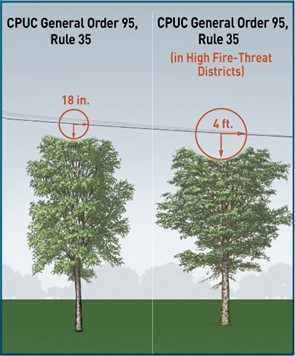
Tree work near transmission lines
To ensure a safe clearance around transmission lines, we follow the below criteria:
- Wire Zone: Vegetation must not stand taller than 10 feet* when fully grown.
- Border Zone: Trees must not stand taller than 15 feet when fully grown.
- Outer Zone: All trees with the potential to fall into powerlines need to be cut down.
*Vegetation within the Wire Zone may not be appropriate in High Fire-Threat Districts.
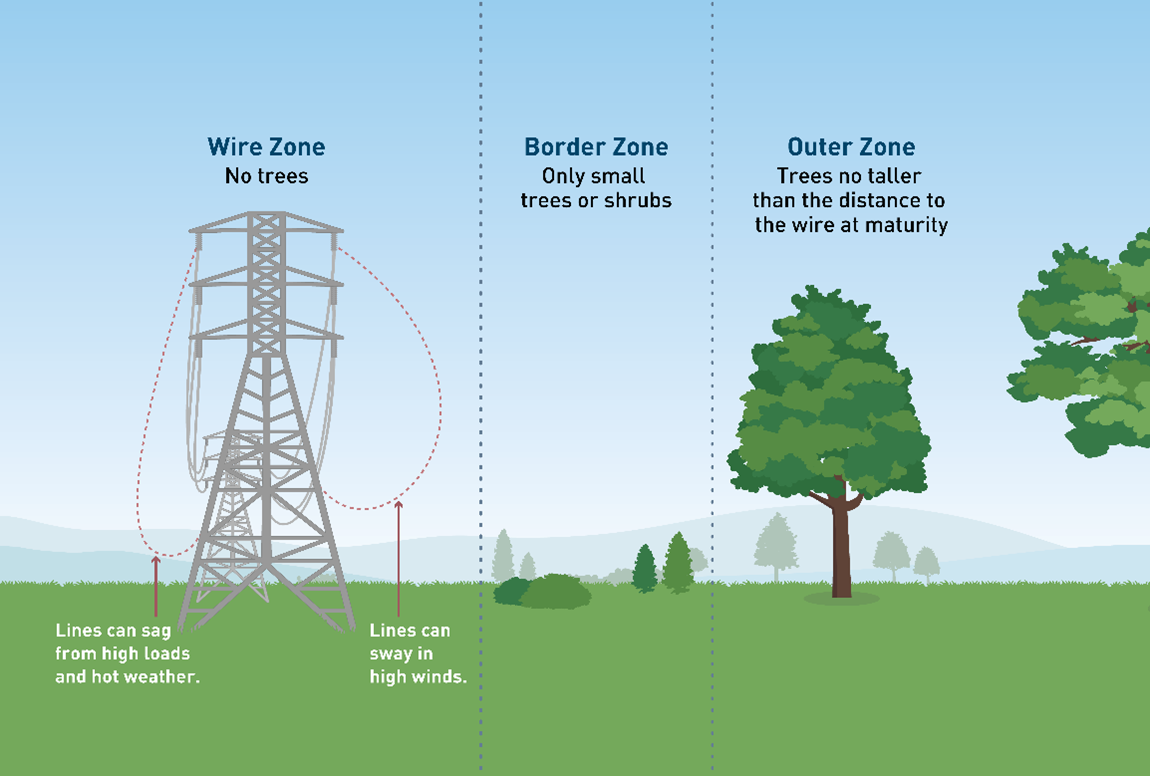
Tree work near poles & towers
We work to keep the area around the base of poles and towers clear of vegetation in areas where CAL FIRE handles suppression and prevention. This includes:
- Removing vegetation in a 10-foot radius around the base of poles and towers.
- Cutting grass and removing brush to at least 8 feet above the ground.
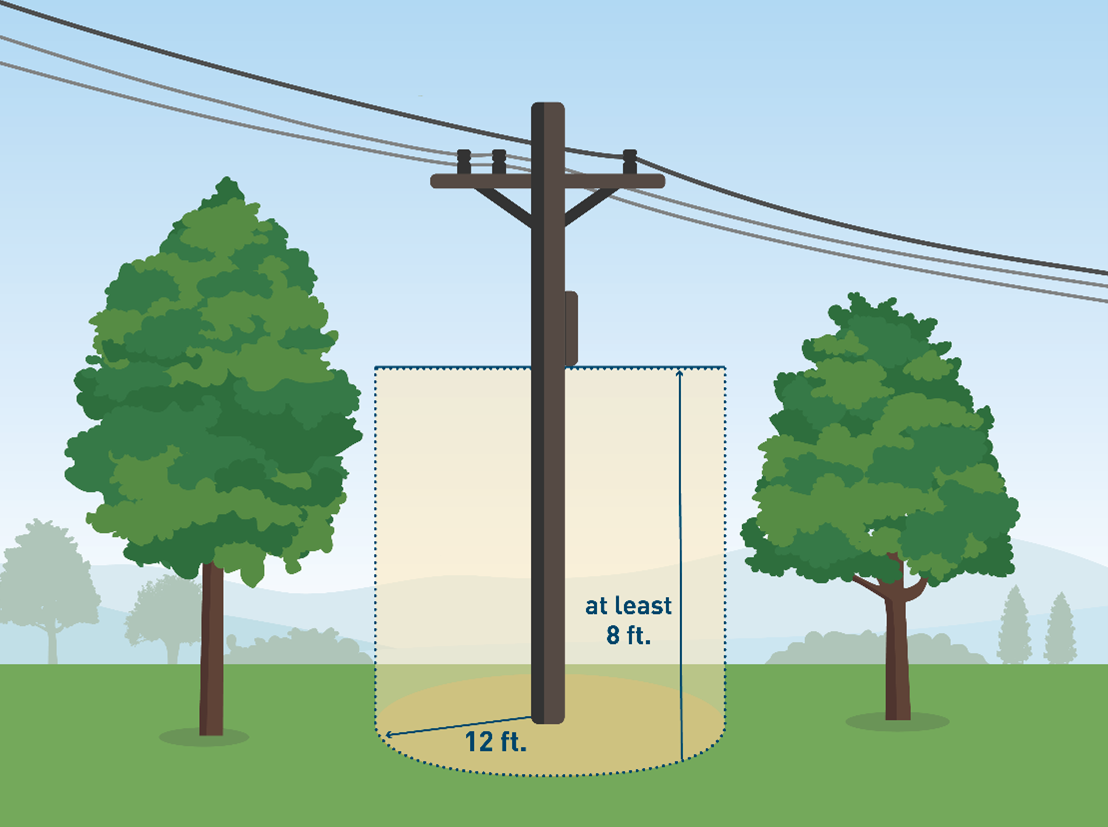
What you can expect
We will call the property owner, conduct a site visit or leave a doorhanger at the property before conducting work.
While work is underway
- We will mark trees with paint or ribbon that need to be trimmed or removed. For more information, download the Marking Trees for Safety Work Fact Sheet (PDF).
- As part of a pilot program in select areas, a small orange tag may be placed on trees. These tags should have minimal impact on tree health and help us conduct necessary safety work to prevent future risks and minimize visits to properties.
- Typically, four to six weeks after the inspection and tree marking, we will return to perform the tree safety work. Timing may vary depending on crew safety and weather conditions. If the work is identified as an urgent safety concern, we will address it right away.
After vegetation work is complete
- Tree branches and limbs that are less than 4 inches in diameter will either be chipped and hauled away or cut into smaller pieces and spread on site.
- Larger wood will remain in a safe position on site. This wood legally belongs to the property owner.
- If you have any questions about the wood from trees we cut down on your property, please reach out to us at 1-800-743-5000.
- Stumps are typically treated to prevent re-growth with an Environmental Protection Agency-approved herbicide that is applied directly to the stump. Any crew member applying herbicides will be supervised by a person with a Qualified Applicator License (or similar certification) from the Department of Pesticide Regulations, a division of the California Environmental Protection Agency.
- Crews may conduct follow-up inspections to ensure work meets required safety standards.
To learn more about how we are addressing wood from trees cut down following recent fires, visit Natural Disaster Recovery.
If you intend to plant
- When planting, it is important to give vegetation the space it needs to grow above and below ground.
- This starts by calling 811 before digging or planting and choosing the right tree for the right location on your property.
- Practicing safe planting helps protect our communities and avoids future tree work. Learn more about safe planting.
Frequently asked questions
Can I opt out of tree pruning or tree maintenance?
This is important safety work that we want to partner with you to complete. Pruning or cutting down trees may be necessary to maintain the required clearance around our powerlines. This ensures the safety of our communities and facilities.
Why does my tree look lopsided after pruning?
We use a method called directional pruning to help trees grow away from our powerlines. Directional pruning is an industry best practice commonly used by utilities. A tree with directional pruning may look unusual but it does not affect the tree's health. This helps keep the required distance between the tree and powerline when cutting it down is not an option.
Why can't PG&E move the power pole or bury powerlines to save the trees in this neighborhood?
Moving power poles to a new location or undergrounding powerlines may take years to complete and does not address the immediate fire threat. Additionally, it would likely require us to cut down more vegetation. Given the growing risk of wildfires, we are taking safety actions to minimize wildfire risks on our overhead lines now. This includes making sure trees are a safe distance from powerlines.
Does PG&E use herbicides on vegetation?
Yes. We may use herbicides as one of the many tools during our tree safety work to help control vegetation near electric equipment. We follow all regulations and recommendations set by the California Department of Pesticide Regulation and the U.S. Environmental Protection Agency (EPA). We also use only EPA-approved herbicides for this tree safety work.
Do property owners get to opt in or opt out of herbicide use?
We notify customers in advance if we plan to use herbicides on their property. A property owner can opt out of using herbicides on their property. However, our crews regularly monitor the area for regrowth during routine inspections. Therefore, customers may be notified again about different vegetation safety work.
Contact PG&E to opt out of herbicide use
What guidelines and rules does PG&E follow when working on trees?
We prune or cut down trees near powerlines to reduce wildfire risk and enhance public safety and service reliability. We also perform this work to comply with a number of state and federal regulations. More information can be found below in laws and regulations.
How do I know which rules may apply to my property?
Vegetation on your property may be subject to state or federal regulations if it is located in a CPUC-designated High Fire-Threat District or CAL FIRE State Responsibility Area (SRA). To find out if you live in an HFTD or SRA, visit the maps below.
What does PG&E do to clean up tree debris after a storm?
After a storm, our emergency crews work to restore power as quickly and safely as possible. We may assist with tree debris cleanup if it supports service restoration. Other utilities, such as phone and cable providers, are responsible for restoring their services. If you see any potential tree- or vegetation-related issues, please report the issue with PG&E Report It.
Why does wood debris remain on site?
Typically, we leave larger wood on site for the customer to use as firewood or remove. This is because the wood legally belongs to the owner. If a property owner would like the wood removed, we recommend contacting your local fire safe council. To find your council, visit cafiresafecouncil.org. For other clean-up options, you may contact your local service organizations, green waste or dump sites, or woodcutters or haulers.
Laws & regulations
When performing our vegetation safety work, as required by law, we do our best to preserve trees. However, if a tree threatens public safety and the electric system's reliability, it must be addressed.
General Order 95, issued by the California Public Utilities Commission (CPUC), requires:
- 18-inch minimum clearance between trees and powerlines year-round.
- 4-foot minimum clearance between trees and powerlines year-round in CPUC-designated High Fire-Threat Districts (HFTD). 12-feet of clearance is recommended at the time of pruning to maintain year-round clearance.
Learn more about the CPUC's Fire Safety Proceeding (PDF).
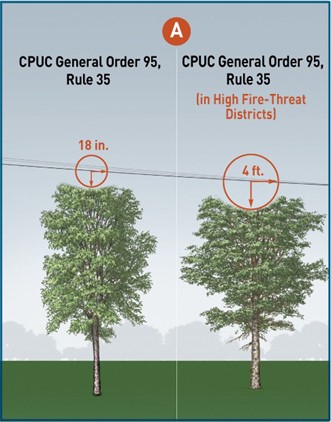
Public Resources Code 4292 is administered by the California Department of Forestry and Fire Protection (CAL FIRE). This law applies during fire season in areas where CAL FIRE is responsible for fire suppression and prevention, and requires:
- Firebreak in a 10-foot radius around the utility pole.
- Removal of tree limbs within that 10-foot radius from the ground to at least 8 feet above the ground.
- Removal of dead, diseased or dying limbs and foliage at least 8 feet above the ground to the conductor.
- Fuel break around specific powerline poles that have pieces of equipment identified as non-exempt by CAL FIRE.
Learn more about the regulations under Public Resources Code 4292.
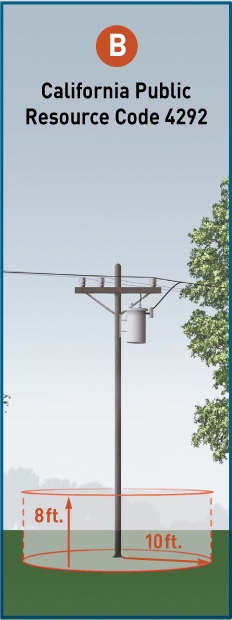
Public Resources Code 4293 is administered by CAL FIRE. Similar to PRC 4292, this law applies in State Responsibility Areas during designated fire season. It requires:
- 4-foot minimum clearance for powerlines between 2,400 and 72,000 volts.
- 10-foot clearance for powerlines carrying 110,000 volts and above.
- Removal of dead, diseased and dying trees that could fall into the powerlines.
Learn more about the regulations under Public Resources Code 4293.
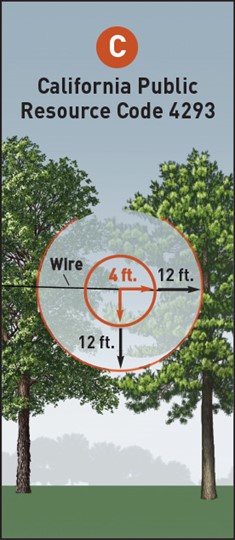
Public Resources Code 4295.5 applies in both High Fire-Threat Districts and State Responsibility Areas. This law:
- Allows PG&E to access land to perform tree safety work prescribed under Public Resources Code 4293 and to prune or remove any hazardous, dead, rotten, diseased, or structurally defective live trees.
- Requires PG&E to notify the landowner and provide an opportunity for them to be heard but does not require PG&E to obtain permission to access land.
- Provides PG&E with the ability to decide how much tree trimming is needed to keep its electric equipment safe. PG&E follows applicable regulations, standards and best practices when conducting tree work.
Learn more about the regulations under Public Resources Code 4295.5.
Following the Governor's January 2014 Drought State of Emergency Proclamation, the CPUC issued Resolution ESRB-4. Under this resolution, utilities are required to take the following measures to reduce the likelihood of fires:
- Increase vegetation inspections.
- Remove hazardous, dead and sick trees and other vegetation near electric powerlines and poles.
- Share resources with CAL FIRE to staff lookouts adjacent to the utilities' property.
- Clear access roads around powerlines for fire truck access.
Learn more about the CPUC's Resolution ESRB-4 (PDF).
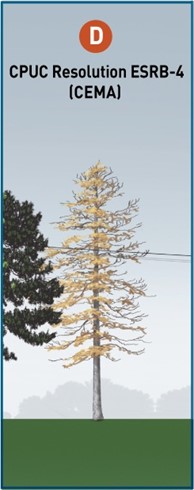
North American Electric Reliability Corporation (NERC) Standard FAC 003-4 is a Federal Energy Regulatory Commission (FERC)-approved standard and applies to all utilities across the United States. It was implemented to stop transmission outages and resulting blackouts due to vegetation contact. The standard directs utilities to manage vegetation clearances between trees and powerlines to ensure the reliable operation of the transmission system.
The standard applies to:
- Transmission line voltages carrying 200,000 volts and higher.
- Certain lower voltage transmission lines identified as critical by the Western Electric Coordinating Council (WECC).
Learn more about the North American Reliability Corporation (NERC).
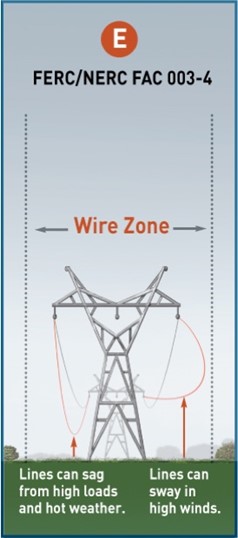
More information to manage trees
CA Fire Safe Council
Learn more about community wildfire risk reduction efforts.
Create a defensible space
Keep your property lean and green to help protect your family and home.
©2026 Pacific Gas and Electric Company
©2026 Pacific Gas and Electric Company

